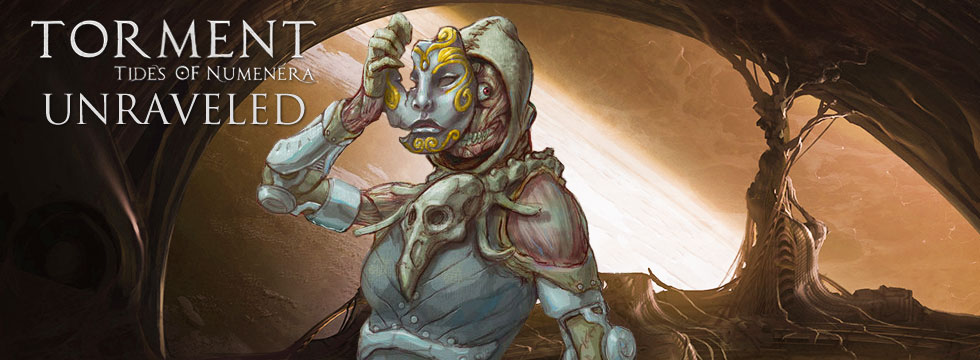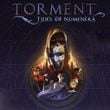author: Luc
Torment: Tides of Numenera Unraveled: "It will be a literary experience that will require some thought to fully enjoy"
We talked with Torment: Tides of Numenera developers, and got answers to the most nagging questions about the mechanics, combat, story, and character progression in the spiritual successor of the cult Planescape: Torment.
Although many of us give up on classic RPGs long ago giving the genre no chances for the future, now their great comeback seems more likely than ever before. First, the release of the fantastic Divinity: Original Sin, soon we will also play Wasteland 2, and there are still such titles as Pillars of Eternity or Torment: Tides of Numenera on the horizon. Regardless of whether they will manage to match their brilliant progenitors from over a dozen years ago, all fans of isometric view and old-school approach to roleplaying, after almost a decade of „fasting” are now getting ready for a big feast and dozens or even hundreds of hours of gameplay.
Part of the team working on the new Torment found a moment for us and agreed to answer our questions. We managed to clear some doubts and even learn some new facts. We interviewed: Kevin Saunders (Project Lead), Adam Heine (Design Lead), and Jeremy Kopman (Crisis Designer).
Game mechanics
The Legacy System expanded from six to sixteen different variations during the Kickstarter campaign. Could you elaborate on that? How are they going to affect the main story? Can we compare the number of legacies with number of possible endings?
Adam Heine (Design Lead): So the sixteen legacies are determined by your Tides. The PC (player character) will have up to two Tides that are „dominant” – that have been increased significantly more than the others Tides. The sixteen legacies, then, are all possible combinations of 0, 1, or 2 Dominant Tides. So talking about your Legacy and your Dominant Tides is kind of the same thing.
Your Dominant Tides will affect a number of things ranging from subtle, cosmetic aspects to unlocking unique content. Some NPCs will react to you differently. Items and abilities might have different bonuses. Certain actions might work better if you have the right Dominant Tide(s)—for example, requesting an audience with a city's leadership might succeed immediately if you have a Silver Dominant Tide. So while the legacies won't change the main story per se, they can affect how you approach it.
And the sixteen legacies will definitely be tied into the ending, although we won't have sixteen different endings. There will be a few main endings, and then a lot of different... pieces that combine into your ending. (So technically I could say we'll have dozens – maybe hundreds – of endings, but that would be marketing spin, and I'm not going to do that to you).

One of the most beloved features of Planescape: Torment was the incredible uniqueness amongst found equipment. Almost every single weapon looked differently and had its own story. Is your approach to items in Torment: Tides of Numenera any close to this one?
Kevin Saunders (Project Lead): Items are very important to the Numenera setting – in fact many items are numenera, which are remnants from past worlds. We do plan to give items unique descriptions and they will help you to understand some facets of the world. How unique they will appear visually is still an open question, though certainly the most significant items will stand out.
What about game difficulty? Are you planning to escalate it somehow? If so – what will change at „hard” in comparison to „normal”? And if not – how do you want to reconcile the expectations and needs of hardcore RPG gamers and casual ones?
Kevin Saunders: We do plan to have difficulty settings, but we aren’t yet prepared to discuss the details of how we’ll approach this feature. In general, we aren’t targeting super casual players, but we are using best practices for UI design and game design to make the game accessible rather than arcane. The quests, storyline, etc. typically don’t take well to different difficulty levels and we aren’t planning much, if anything, there. Meanwhile, because the Crises are hand-crafted experiences, and fairly few in number, we hope we can be somewhat sophisticated in how we alter them based on difficulty.
So as to not fully evade your question, here are a few specific examples (or counter examples):
Opponents: On harder difficulty settings, we may add additional enemies that create more tactically challenging encounters.
Difficult Tasks (DT): If we do make DTs harder at higher difficulties, it won’t be by much. This method of difficulty scaling fundamentally alters too much of the gameplay, making many Skills less useful, which disrupts the balance of a variety of things.
Friendly fire: We will likely have friendly fire active in all difficulty modes and not something that changes due to the difficulty setting. With the turn-based combat, making your party immune to friendly area of effect abilities would fundamentally alter the nature of those abilities and undermine the tactics.
Resting: You may get more “rests” at easier difficulty levels, allowing you to be a little less discerning about when to spend Effort.
Randomness: Not really a difficulty thing, but another axis we’ve toyed with as a game option is the degree of randomness. We are planning for randomness to play a factor in some aspects of gameplay and not others, but might let the player adjust some of this. For example, in Numenera weapons typically inflict a fixed amount of damage, which affects the flavor of combat compared to random damage.
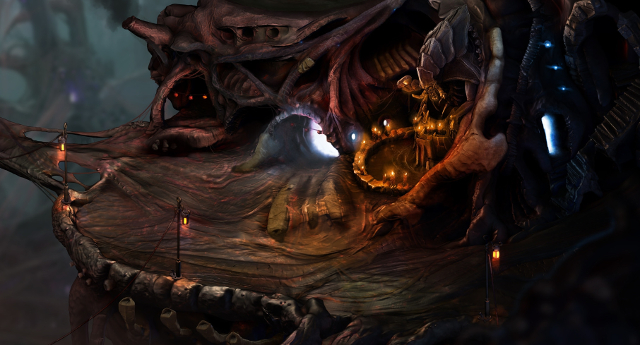
You often point to responsiveness of the game world as the core element of Torment: Tides of Numenera. But at the same time, you keep saying that The Beyond is inhabited by fairly isolated groups and communities. Does it mean that our reputation will be restricted to certain regions? How are non-playable characters supposed to know “how to treat us”?
Kevin Saunders: The world’s reactivity isn’t so much about your reputation as it is about the consequences of your decisions. Some of the reactivity will be grand, but much will be more subtle, increasing verisimilitude, but not moving mountains. For example, if you open a cross-dimensional portal, and leave it open, then you might expect others will use it as well.
We do plan to have some reputation-like reactivity – you are building a legacy, after all. If you are well known, then how people would know of you would depend upon your dominant Tide(s). For example, a Silver PC would be like a celebrity, while a Blue PC might be known for their intelligence or commitment to reason.
Modern RPGs are often forced to follow in Skyrim's footsteps and implement open worlds with tons of activities in order to succeed. On the other hand, the example of The Witcher or Dragon Age series have proven that focusing on the story with linear gameplay is still relevant. Which approach have You decided to be more fitting for Torment: Tides of Numenera?
Kevin Saunders: Our emphasis is on your story and we’re not attempting to create a Skyrim-like experience. One could create a fabulous game that explores Numenera’s Ninth World, but it would be out of scope for TTON and force us to dilute the personal story-driven experience we are creating.
One of the things that made Planescape: Torment so recognizable was the inability of our protagonist to die. How did you approach the permanent death issue in Torment: Tides of Numenera? Castoff's Labirynth sounds very interesting but does its existence mean that our character is an immortal again?
Kevin Saunders: We don’t want to reveal more about the details of the Castoff’s Labyrinth or how we plan to handle death. The situation that TTON’s PC is in is quite different from the plight of the Nameless One – while there is a component of multiple incarnations for both, in TTON, these incarnations aren’t directly related to death. Being a castoff of the Changing God, the PC’s body did exist prior to the events at the beginning of the game, but his or her consciousness is born the instant you begin playing.

Story and companions
Unfortunately, you were unable to acquire the copyrights for Planescape: Torment and the game will be set in a completely different universe. Can we at least expect some easter eggs and references to the Nameless One, Morte and others from the original?
Kevin Saunders: TTON fans will catch glimpses of PS:T but we don’t plan to have direct references.
Even though there is still a lot of work to do, the core of the story is probably already finished. How much time will it take to complete the game? Planescape: Torment provided from 40 to 50 hours of pure gameplay in addition to almost 800 000 words to read. Can we expect similar numbers in Torment: Tides of Numenera?
Kevin Saunders: Yes, the core of the story is finished (though elements of it will be iterated upon through to the end). We don’t want to make guesses as to what the final gameplay length will be, but I expect we’ll be somewhat shorter than PST, though no less dense. In part this is because we won’t have the dungeon crawling sections that PST did. We will definitely have a lot of words, be they dialogue or descriptions. (We’ve written/implemented over 50,000 dialogue words already and we’re not yet in full production.)
Considering who created and developed all of the eight companions, there is no doubt that they will be great, interesting characters but this question still needs to be asked. Is it possible to finish the main story completely alone?
Kevin Saunders: We won’t deliberately prevent that possibility, but we’re giving low priority to making certain the game’s not too difficult to solo. That is, it may well be possible, but we’re not investing energy on maximizing that type of playthrough. The reason just has to do with scope – we expect the majority of players, at least on their first playthroughs, to interact with the companions, so we are focusing on the party-based experience.
Nowadays modern RPGs cannot exist without romancing options. Previous games from the genre were not avoiding this either – even Planescape: Torment had some kind of love story involving the Nameless One and Annah. Will we able to take relations with our companions to the „next level”? Will it affect the story somehow?
Kevin Saunders: Love can indeed be part of one’s legacy, but including love stories is not a focus for us. The types of relationships you can develop depend upon the specifics of the characters and situations – to the extent that any deep connections can be established, it will be because they arose naturally through the story, not because we preplanned them. Of course, romantic love is only one flavor of love.
What about the replayability of Torment: Tides of Numenera? Will making other decisions affect the main plot enough to encourage players to play through it again?
Kevin Saunders: We are not being shy about precluding content based upon the player’s choices. That richness of experience is a higher priority to us than the gameplay length of a single playthrough.

Character progression and customization
We already know that in Torment: Tides of Numenera traditional good-bad/lawful-chaotic distinction will be replaced with Tides own system. Will they only affect dialogues and the final legacy of our character or perhaps will they have a greater meaning?
Adam Heine: The Tides will affect some dialogues, items, and ability bonuses and unlock certain content (not a lot, but enough). We want them to have a subtle effect on almost everything, with an obvious effect on a few things. For example, a certain percentage of the population is "Affected" by the Tides, even if they're not aware of it. In talking to these NPCs, then, you might find that your Dominant Tides change their attitude toward you or make them more amenable to talk. If you know what Tides they are most aligned with, you can use that to choose arguments that will be most likely to influence them.
As for meaning, the Tides and Legacies are a major component to the question of what does one life matter? The themes of the Tides will be explored throughout the entire game.
With all its uniqueness, Torment: Tides of Numenera still remains a classic RPG. How did you approach character progression – one of the most important aspects of this genre? Will there be a traditional, level-based system with some cap or something else? How will we gain experience anyway?
Adam Heine: A lot of TTON's character progression is based on the Numenera tabletop game. It is a level-based system, but not as stringent as traditional RPGs. Characters spend XP on different aspects of development: skills, stats, etc. And after every four aspects they develop, their character goes up to the next level or Tier. At each new Tier, they gain new abilities from their class (called their Type in Numenera) and their Focus.
The tabletop game caps characters at 6th Tier. That sounds low, but given the way XP gains and expenditures work in the game, it works out pretty well, timewise. Torment will probably stick to that same cap, but we can't say for sure until we have more of the game built and can really start to balance things.
XP in Numenera is gained through "discovery." In a lot of ways, this is what you'd expect: you gain XP from solving quests, finding out cool things, fixing problems, etc. One main difference between Numenera and other RPGs is that you don't gain XP just from killing bad guys. Killing is just a means to an end. It's a valid means in a cRPG, of course, but the end is where you get the XP, regardless of how you got there. So if you kill, it's because that's the way you choose to solve your problems, not because you wanted more XP.
Having no advanced character creator worked just fine for Planescape: Torment. Will we be able to create our own hero with a unique portrait and name in Torment: Tides of Numenera or are you going to impose the same looking protagonist on everyone?
Adam Heine: PST focused on the story of a single, unique protagonist. The Nameless One's story wouldn't have worked as well if every player got to choose their own name, portrait, and backstory. It was part of what made PST a Torment game.
TTON follows that same tradition. We have a specific story to tell, and that requires a specific protagonist. We are, however, breaking from PST's tradition a little in that we are allowing the player to choose between a male or female protagonist, which will affect the portrait (obviously) and some reactivity throughout the game. But regardless of gender, you are still the Last Castoff, and your story will start the same.
Put another way, Torment cares about the choices you make in the game, not before it.
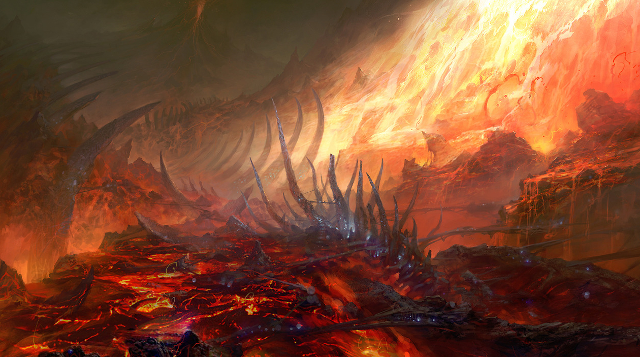
Combat
Despite some controversies, you eventually decided to implement turn-based combat. How are you going to make it more appealing to people who prefer the “real-time-with-pause” system? You have mentioned a couple of times the so-called Crises – could you elaborate on that? How often will we participate in them? What would you compare them to?
Jeremy Kopman (Crisis Designer): A Crisis will occur in any situation in TTON where the passage of time is important to the way that encounter plays out. The simplest form of this would be combat, where it is important when each character takes their action. A more complex Crisis could include combat, dialogue, stealth, or interactions with the environment – as long as there is some reason for these elements to be time-sensitive, such as a ticking detonation device, a rising tide of swirling caustic chemicals, or a phalanx of guards marching toward your hidden party. The comparison that has been a guiding principle in our development is a tabletop RPG encounter. In a tabletop game, when you get into combat, you aren’t restricted to sword-slicing and spellcasting. If you are playing a physically strong character, you can ask if you can push a boulder in front of a door to cut off some enemies. If you’re playing a charismatic character, you can talk the enemies down. These types of options will be available to you in Crises. And the Crises will also have narrative significance, if not in the main storyline, then at least in local events – much like in some tabletop campaigns.
We’re planning to have at least 10 full-scale Crisis situations throughout the game, with our goal being that you’ll engage in them with enough regularity to keep the pace varied and interesting. But you’ll probably notice that you aren’t entering combat as often as you would in a more conventional RPG. We plan to have potential smaller fights and time-sensitive situations, but the brunt of our efforts will be on refining the major Crises. With this focus, we’re hopeful that we can craft each situation to be as responsive and reactive to a player’s choices as possible. Since we can’t be quite as flexible as a human GM, we’re investigating UI elements and approaches to the environment art to help players understand what they can interact with and how, as well as knowing what to expect to happen when they do so. While none of this may directly assuage the fears of people who are more interested in the fast pace of RTwP combat, we think that the greater array of options and tactical decisions allowed in Crises will convince them that we made the right choice for TTON.
It was never a secret that Torment: Tides of Numenera will be focused on telling a story rather than making us fight hordes of enemies. Does it mean that a completely non-violent walkthrough is possible?
Adam Heine: One of the things PST did was it allowed you to talk your way out of almost every situation. And if you tried really hard, you could get through the entire game and only have to kill two characters (and one of them wasn't even really dead).
We chose to take that a bit further. We want there to be different paths to solving every problem in the game. In many cases, one of those paths will be violence, but there will be a way to solve things peacefully or with brains or stealth in all cases. So yes, it is our goal to make it possible to get through the entire game without killing a single creature.
Not that it will be easy, of course. You may have to play the game a couple of times before you figure out how to avoid killing certain enemies. But possible? Absolutely.
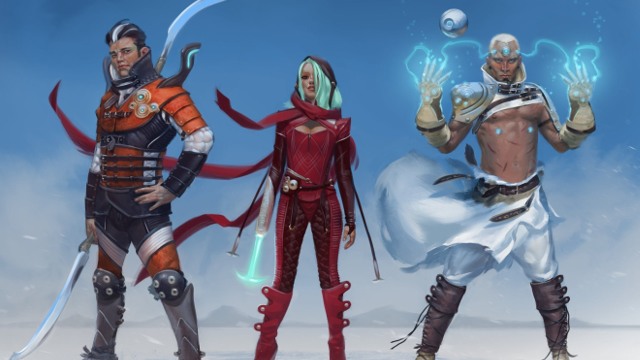
Will choosing whether to fight or to talk our way out be equally “profitable” and appealing? Are you doing anything to avoid situations when the player gets the feeling that he “was supposed to talk/fight here” to get better results?
Jeremy Kopman: The answer to this question will be different for each individual Crisis. Thinking about real life, there are some situations where talking your way out of a pinch is obviously smarter than punching the 7-foot tall bouncer with a bad-ass scar on his face. Other times, no amount of talking is likely to save you from a dust-up. So while we’ll design Crises so that any good character build will have options, and over the course of the whole game you’ll feel satisfied with the “profitability” of those options, each Crisis will have different paths and outcomes that befit the scenario. Generally, we’re designing these alternatives such that the outcomes match the expectations of players who choose them, creating satisfying reactivity even if not strictly “equal” to all alternatives.
What will the turn-based combat look like? Do you want Torment: Tides of Numenera to be more like the Fallout series with renewable action points or is it going to be focused on “one turn-one action” mechanism?
Jeremy Kopman: Drawing from the Numenera tabletop rules, we’re intending to use a “one turn-one action” model. While we considered action points and a few other, more esoteric options, we feel that the Numenera method fits the Crises best in keeping your options clear without requiring you to track another resource. We also feel we can achieve better balance across all esoteries, fighting moves, and tricks of the trade (i.e., character abilities) as they all have basically the same cost in time for the character. This offers a solid constant from which to adjust all the other variables like range, damage, duration, stat pool cost, etc. The intended effects of these abilities are extremely varied such that we think the system will be sufficiently complex and tactically interesting without also introducing an action point component. We are still prototyping and experimenting with the specifics of combat and we may change our position on this decision as we develop more Crises, but this is where we’re currently at.
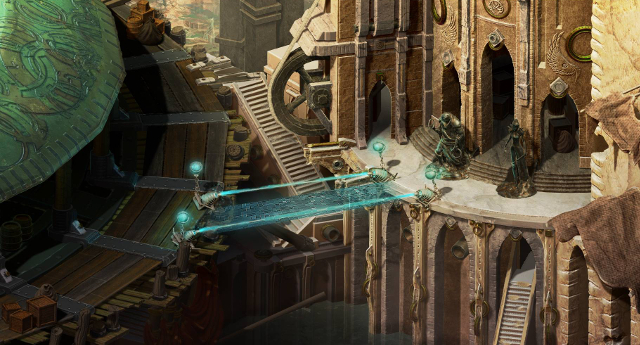
Graphics and sound
Torment: Tides of Numenera will be set in isometric 2.5D. Even though pre-rendered backgrounds tend to look absolutely astonishing, some players are seeing this as a step backwards – especially if you consider free-rotating camera in Wasteland 2. Why did you choose this perspective?
Kevin Saunders: This was the Infinity Engine way and part of the PST experience in our opinion. We were also inspired by the pre-rendered background approach being taken by Pillars of Eternity. While having a free camera provides some benefits, they aren’t particularly important to the type of gameplay TTON will have. Throughout many aspects of our design, you’ll find that we are taking a hand-crafted approach that favors quality over quantity. For example, we’re avoiding filler combat, focusing instead on a relatively small number of narratively relevant Crises. So, too, for the environments – the fixed camera and pre-rendered backgrounds allow us to better craft the visual experience.
Are you planning to record some voice-overs and cutscenes? Although both are pretty time- and money-consuming, lack of them may repel some of the players who are not used to such a large amount of text.
Kevin Saunders: We are planning to have voiceover for at least some lines for the more important characters, such as companions. The voice helps define the characters and adds impact to the most important scenes. We will have some in-engine cut scenes, but they will be simple compared to what many may be used to. Grand cutscenes could be terrific, but it’s not worth sacrificing other aspects of the game to afford them. As for text... players who do not find a large amount of text to be enjoyable have perhaps chosen the wrong game. TTON will be a literary experience that will require some thought to fully enjoy.
In terms of game localization, are you going to record additional lines in languages other than English or will it be subtitles-based?
Kevin Saunders: Great question. Fully localizing voice for other languages isn’t realistic with our budget – even with the great support we received from international RPG fans, it’s just not financially viable. (We do plan for the system to be flexible enough for ambitious fans from other countries to create their own localized VO packages.
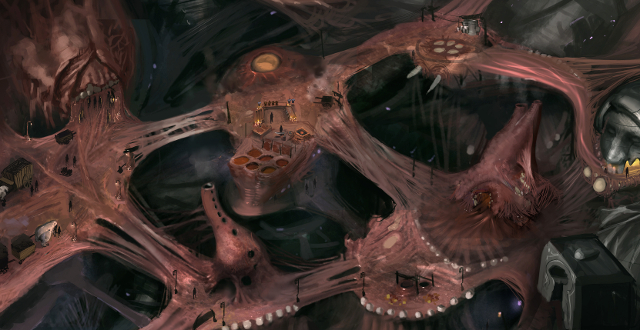
Others
From the very beginning, you have emphasized that the territories present in Torment: Tides of Numenera will be only a small part of the Ninth World. Does it mean you are planning to publish expansions or perhaps create other games within the same universe?
Kevin Saunders: We are currently focused on TTON (and Wasteland 2) and we don’t have any plans along these lines. For the future, sure, it is a possibility, but that’s far from now. The Ninth World is a very interesting realm to explore. And while it is suitable for a Torment story, it could be the home for many other types of stories as well. For TTON, we chose to set the game away from the core regions described for Numenera so that we would have more flexibility, especially as our development of TTON’s story was occurring before the Numenera corebook had been finalized.
Even though world of Numenera is giving almost endless possibilities in terms of creativity, you probably had some difficulties during the design process. What was the biggest challenge and what took (or is still taking) the biggest amount of time to create? The Bloom? Castoff's Labirynth?
Adam Heine: One of the most difficult parts of designing a Numenera game is getting everyone on board with the ideas behind the setting. Some people want Numenera to be "medieval times with sci-fi trappings." Some want to define what each of the prior worlds were, what their technology was, what they looked like and talked like, etc. Some want to drop 21st-century technology into the setting and obscure it by having the people call it something ignorant.
While each of those has some relevance in Numenera, all of them miss the mark. Monte Cook and Shanna Germain have beaten it into our heads over and over again (in a good way) that Numenera is about the mystery and the weird. The Ninth Worlders understand things like democracy, the Earth's revolution around the sun, and ink pens. They don't refer to weapons as "guns" or vehicles as "cars," not because they are ignorant, but because the technology from the prior worlds is far more advanced and alien than that. Most importantly to the setting is that the strange powers and technology that exist would seem like magic to us, because it has been a billion years since our time and literally nothing that we have made will have endured that long, and billions of inventions and sciences that we can't even dream of have been researched, applied, and forgotten.
When we write a story or design an area within the Bloom, for example, it's easy to expect that the reader or player will ultimately understand the city-creature that is the Bloom. But the nature of this creature – and of Numenera in general – is so alien to us that even if we could speak to it, we wouldn't be able to make sense of what it wants (and just when we thought we understood, it would do something to prove us completely and fatally wrong).
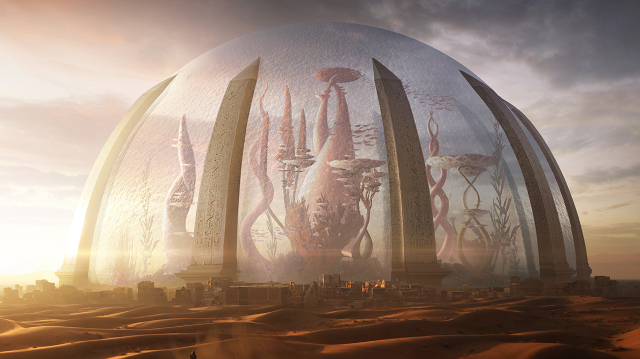
George Ziets has done a fantastic job of getting this across in his high-level design for the Bloom Zone, not just with the concept of the Bloom, but the whole concept of how Ninth Worlders, even though they can never understand something, know how to use the numenera to their advantage. To them, the Bloom is a black box where you do certain things to get what you want, at least until it changes its mind, swallows your consciousness, and leaves what's left of you to wander through its passages as a mindless ghost for all eternity...
Are you planning to make Torment: Tides of Numenera mod-friendly? A lot of modern RPGs clearly benefit from allowing its fans to create their own adventures – will you do the same?
Kevin Saunders: We won’t do things to specifically preclude mod development, but it’s not a priority for TTON. It’s not part of what we presented to the backers and we don’t want to distract from the core game. Anything we did do would be post-release in any event.
At what stage of development are you at the moment? When can we expect the announcement of the release date?
Kevin Saunders: We are in a limited production phase. We are creating actual content for the game, but are doing so in ways that prioritize proving out ideas, improving tools and pipelines, etc. We’re not yet focused on creating content at the fastest pace possible. Instead, our currently small team is building the strongest foundation we can so that as our production team rolls off of Wasteland 2, we’ll be able to progress more efficiently. We recently announced Q4 2015 as our release date, which takes into account the additional time that Wasteland 2 has been in production. We won’t announce an exact release date until close to then as we want to continuously be able to make decisions based upon what’s best for the game. It can be unwise to speak of a release date until the game is good enough to ship. At that point, you’re just polishing further and the unknowns are resolved, and you can hit a date without any risk to quality.
